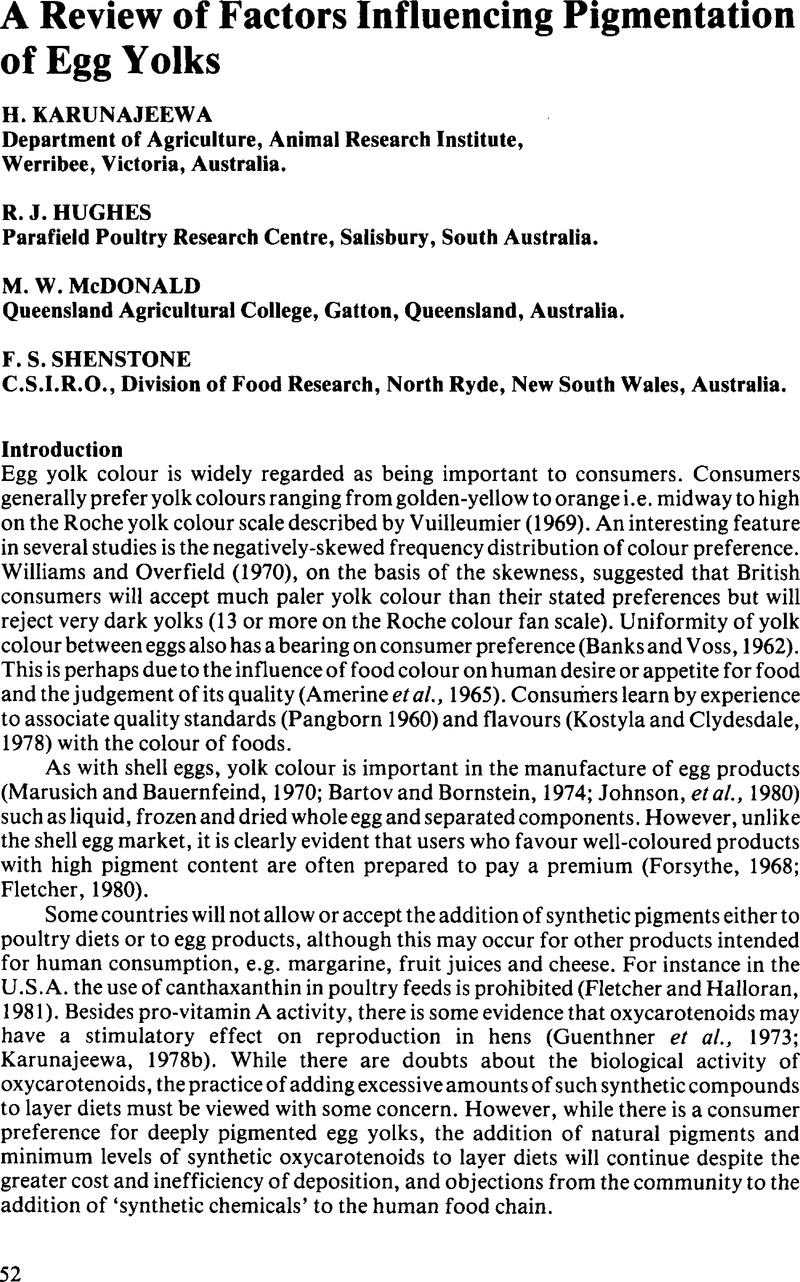Crossref Citations
This article has been cited by the following publications. This list is generated based on data provided by Crossref.
Stadelman, W. J.
1986.
Egg Science and Technology.
p.
37.
WOODWARD, S.A.
JANKY, D.M.
and
HARMS, R.H.
1986.
The Influence of Light on Egg Yolk Pigmentation.
Poultry Science,
Vol. 65,
Issue. 3,
p.
508.
BELYAVIN, C.G.
and
MARANGOS, A.G.
1987.
Recent Advances in Animal Nutrition.
p.
47.
Lang, M. R.
and
Wells, J. W.
1987.
A Review of eggshell pigmentation.
World's Poultry Science Journal,
Vol. 43,
Issue. 3,
p.
238.
Karunajeewa, Hector
and
Tham, Sing H.
1987.
The effect of rice pollard and manganese levels in the diet on egg weight, shell quality and performance of crossbred layers.
Journal of the Science of Food and Agriculture,
Vol. 41,
Issue. 2,
p.
141.
BELYAVIN, C.G.
and
MARANGOS, A.G.
1989.
Recent Developments in Poultry Nutrition.
p.
239.
FLETCHER, D.L.
1992.
Methodology for Achieving Pigment Specifications.
Poultry Science,
Vol. 71,
Issue. 4,
p.
733.
Frigg, M.
Whitehead, C. C.
and
Weber, S.
1992.
Absence of effects of dietary α‐tocopherol on egg yolk pigmentation.
British Poultry Science,
Vol. 33,
Issue. 2,
p.
347.
Wahlstrom, A
Tauson, R
and
Elwinger, K
1999.
Production and egg quality as influenced by mash or crumbled diets fed to laying hens in an aviary system.
Poultry Science,
Vol. 78,
Issue. 12,
p.
1675.
Baiao, N.C.
Mendez, J.
Mateos, J.
García, M.
and
Mateos, G.G.
1999.
Pigmenting Efficacy of Several Oxycarotenoids on Egg Yolk.
Journal of Applied Poultry Research,
Vol. 8,
Issue. 4,
p.
472.
Hertrampf, Joachim W.
and
Piedad-Pascual, Felicitas
2000.
Handbook on Ingredients for Aquaculture Feeds.
p.
142.
Grobas, S.
Méndez, J.
Lázaro, R.
de Blas, C.
and
Mateo, G.G.
2001.
Influence of Source and Percentage of Fat Added to Diet on Performance and Fatty Acid Composition of Egg Yolks of Two Strains of Laying Hens.
Poultry Science,
Vol. 80,
Issue. 8,
p.
1171.
Akiba, Y.
Sato, K.
Takahashi, K.
Matsushita, K.
Komiyama, H.
Tsunekawa, H.
and
Nagao, H.
2001.
Meat Color Modification in Broiler Chickens by Feeding Yeast Phaffia rhodozyma Containing High Concentrations of Astaxanthin.
Journal of Applied Poultry Research,
Vol. 10,
Issue. 2,
p.
154.
Bosma, Theresa L.
Dole, John M.
and
Maness, Niels O.
2003.
Optimizing Marigold (Tagetes erecta L.) Petal and Pigment Yield.
Crop Science,
Vol. 43,
Issue. 6,
p.
2118.
Ri, Eishu
Sato, Katsunori
Oikawa, Takuro
Kunieda, Tetsuo
and
Uchida, Hideji
2005.
Effects of Dietary Protein Levels on Production and Characteristics of Japanese Quail Eggs.
The Journal of Poultry Science,
Vol. 42,
Issue. 2,
p.
130.
Sirri, F.
Iaffaldano, N.
Minelli, G.
Meluzzi, A.
Rosato, M.P.
and
Franchini, A.
2007.
Comparative Pigmentation Efficiency of High Dietary Levels of Apo-Ester and Marigold Extract on Quality Traits of Whole Liquid Egg of Two Strains of Laying Hens.
Journal of Applied Poultry Research,
Vol. 16,
Issue. 3,
p.
429.
Chowdhury, Sachchidananda D.
Hassin, Begum M.
Das, Shubash C.
Rashid, Md. H.
and
Ferdaus, Abu J.M.
2008.
Evaluation of Marigold Flower and Orange Skin as Sources of Xanthophyll Pigment for the Improvement of Egg Yolk Color.
The Journal of Poultry Science,
Vol. 45,
Issue. 4,
p.
265.
Olson, J.B.
Ward, N.E.
and
Koutsos, E.A.
2008.
Lycopene Incorporation into Egg Yolk and Effects on Laying Hen Immune Function.
Poultry Science,
Vol. 87,
Issue. 12,
p.
2573.
2009.
Safety of use of colouring agents in animal nutrition - Part III: ß-apo-8’-carotenal, ethyl ester of ß-apo-8’-carotenoic acid, lutein, zeaxanthin and concluding remarks.
EFSA Journal,
Vol. 7,
Issue. 5,
p.
1098.
Hipfner, J. Mark
Hobson, Keith A.
Dale, James
and
McGraw, Kevin J.
2010.
Stable Isotopes Link Diet to Avian Yolk Carotenoid Allocation: A Comparative Study of Five Auk Species (Charadriiformes: Alcidae).
Physiological and Biochemical Zoology,
Vol. 83,
Issue. 3,
p.
481.


